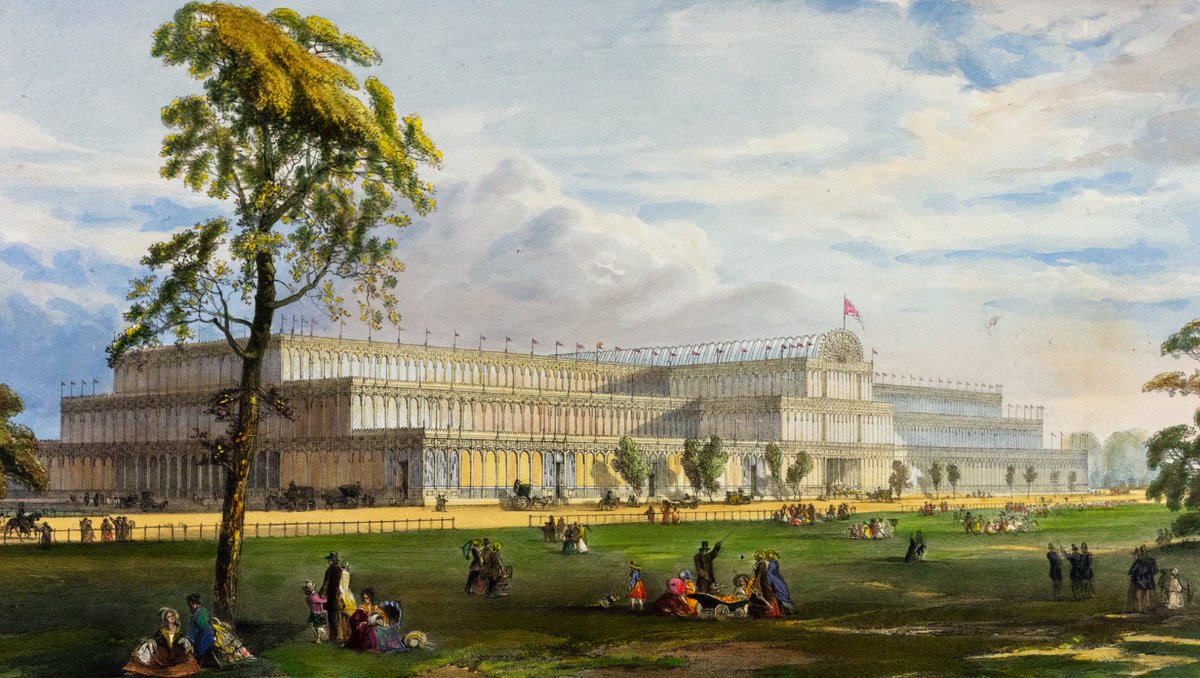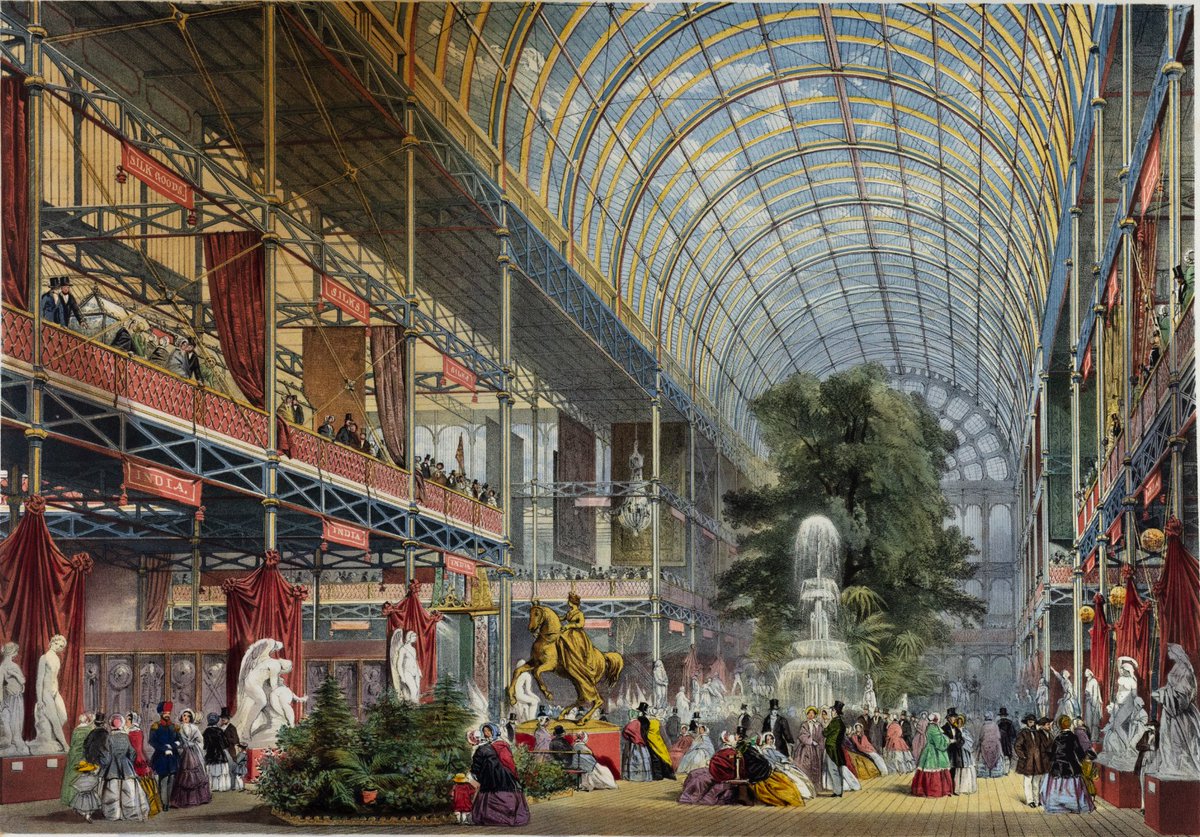You& #39;ve probably heard of the Great Exhibition of 1851, the first World& #39;s Fair, held in the remarkable Crystal Palace.
It had 6 million visitors, and took place in the largest enclosed structure that had ever been built.
But what was it actually for? A thread:
It had 6 million visitors, and took place in the largest enclosed structure that had ever been built.
But what was it actually for? A thread:
The idea of an exhibition in Britain originated in the 1840s, led by the civil engineer Francis Whishaw, who was also secretary of the Society for the Encouragement of Arts, Manufactures and Commerce ( @theRSAorg) - the subject of my book, just out: https://www.amazon.co.uk/Arts-Minds-Society-Changed-Nation/dp/0691182647/ref=tmm_hrd_swatch_0?_encoding=UTF8&qid=&sr=">https://www.amazon.co.uk/Arts-Mind...
Whishaw had seen the use of industrial exhibitions in France, as a means of catching up with British technology.
Every few years since 1798, the French government had held an exhibition of its national industries in Paris.
They were a big deal:
Every few years since 1798, the French government had held an exhibition of its national industries in Paris.
They were a big deal:
The state paid for a grand temporary building, and paid the expenses of the exhibitors. And the very best exhibitors were even admitted to the coveted Légion d’honneur. So, naturally, every manufacturer wanted to take part.
But the investment by the state was well worth it:
But the investment by the state was well worth it:
In the days before GDP statistics, exhibitions gave a detailed snapshot of the nation& #39;s manufacturing capabilities. They were like industrial audits.
By knowing who was ahead or behind, the state could work out which industries to subsidise, or which subjects to teach in schools
By knowing who was ahead or behind, the state could work out which industries to subsidise, or which subjects to teach in schools
The exhibition prizes could also be used to direct the efforts of industrialists toward solving particular problems - they were a tool of the French government& #39;s industrial strategy.
Yet they were also a means of improvement more generally:
Yet they were also a means of improvement more generally:
Motivated by the prizes on offer, manufacturers would try to outdo one another each year. Exhibitions thus provoked a spirit of competitive emulation, while revealing to manufacturers the latest tech and most fashionable designs.
And exhibitions harnessed the visiting public.
And exhibitions harnessed the visiting public.
When consumers were uninformed, manufacturers could easily become complacent, finding that people bought their wares even when their products were not very good. They had little incentive to improve.
But exhibitions shattered this complacency.
But exhibitions shattered this complacency.
By showing consumers what was possible, exhibitions educated them in taste and forced manufacturers to cater to their heightened demands. Once the paying public had been exposed to the best, they would settle for nothing less.
In all, by 1844 alarm bells in Britain were ringing.
In all, by 1844 alarm bells in Britain were ringing.
France appeared to be catching up in terms of mechanisation and mass production, and in some respects was pulling ahead.
Britain, by contrast, had not undertaken a comparable national industrial audit. Without an exhibition of its own, how could it hope to remain competitive?
Britain, by contrast, had not undertaken a comparable national industrial audit. Without an exhibition of its own, how could it hope to remain competitive?
So Francis Whishaw began the work of getting the Society of Arts to organise such an event - a national exhibition of industry for Britain.
And although his initial plan came to nothing, it was soon resurrected by a new member of the Society, the civil servant Henry Cole.
And although his initial plan came to nothing, it was soon resurrected by a new member of the Society, the civil servant Henry Cole.
Cole was a force of nature, pretty much taking over the entire Society within a matter of months. It became an exhibition-holding organisation.
And in 1849, at the latest Paris exhibition, he adopted the all-important idea: that of holding an exhibition that was international.
And in 1849, at the latest Paris exhibition, he adopted the all-important idea: that of holding an exhibition that was international.
This was the crucial step because an international exhibition of industry appealed to the hugely popular free trade movement in Britain. By displaying the products of other nations, the argument went, British consumers would demand that they be able to buy them more cheaply.
And free trade would hopefully bring an end to war, too. Free trade campaigners argued that the productive classes of rival nations competed peacefully, simply by trying to outdo one another in the quality and quantity of what they produced.
Unlike the aristocracy.
Unlike the aristocracy.
It was the aristocracy, they argued, who let the competition become violent, feeding their pride by causing destruction. So a grand exhibition of the products of all nations — the Great Exhibition — would be a physical manifestation of free trade and international harmony
By appealing to the free traders, Cole was able to make the Great Exhibition a reality. The state would not pay, so it was funded by subscriptions - essentially, crowdfunding.
The free traders provided the crowd, with Cole selling it as a “competition of arts, and not of arms”.
The free traders provided the crowd, with Cole selling it as a “competition of arts, and not of arms”.
So, rather than just a big event with lots of visitors, the Great Exhibition was envisioned as an engine of free trade and world peace, exciting competitive emulation between manufacturers and educating consumers.
And in many ways, it succeeded.
And in many ways, it succeeded.
The Great Exhibition and its successors spurred dozens of examples of international cooperation - from international postal agreements, to harmonisation of intellectual property.
Even the first international chess tournament was held in 1851 in London to coincide with it!
Even the first international chess tournament was held in 1851 in London to coincide with it!
And by serving as an audit of the world& #39;s industries, it gave reformers the ammunition to push for changes where Britain seemed to be falling behind...
But that& #39;s a story for another time, and is in my book!
For more & a discount on the book, see here: https://antonhowes.substack.com/p/age-of-invention-the-power-of-exhibitions">https://antonhowes.substack.com/p/age-of-...
But that& #39;s a story for another time, and is in my book!
For more & a discount on the book, see here: https://antonhowes.substack.com/p/age-of-invention-the-power-of-exhibitions">https://antonhowes.substack.com/p/age-of-...

 Read on Twitter
Read on Twitter



